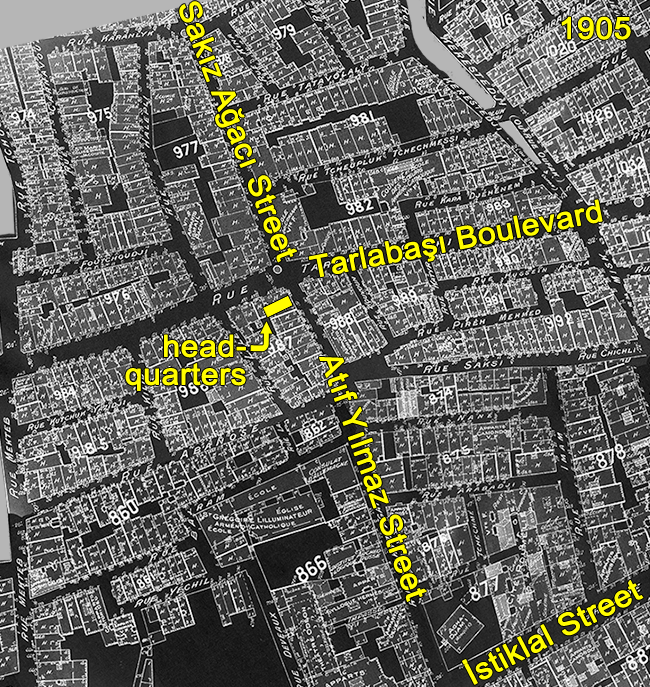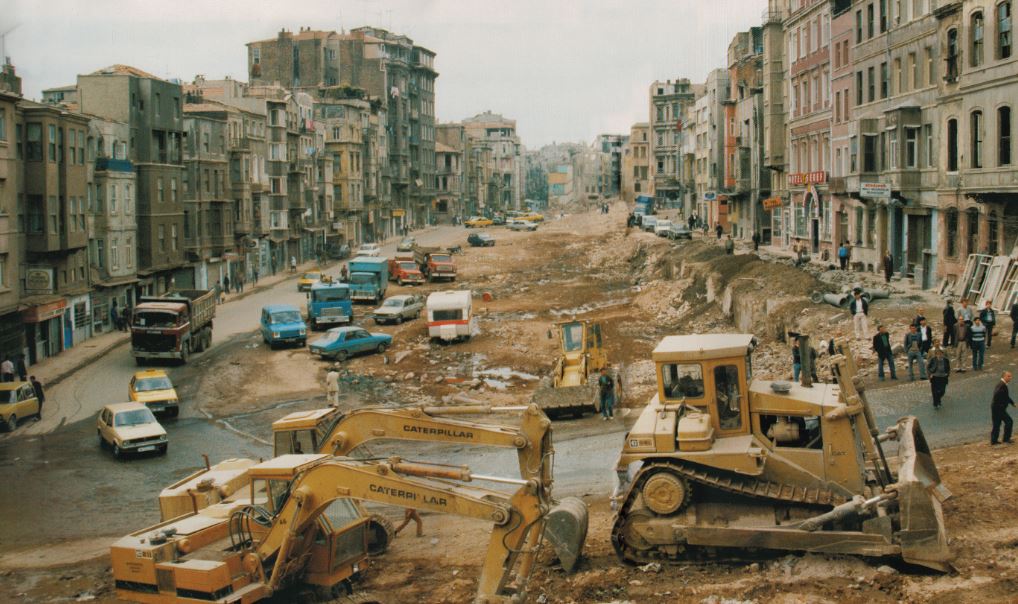Varak Ketsemanian and Daniel Ohanian
Of the plethora of contexts from which the history of the Armenian
Revolutionary Federation (ARF) is inextricable, that of the late 19th-/early 20th
-century Ottoman Empire is among the most important. As a prominent
political party, the ARF came to the forefront of Ottoman politics
particularly after the July 1908 Constitutional—or Young
Turk—Revolution, in which it played an important role. While it had had
underground cells, secret meeting places, and an organizational network
in Istanbul (Constantinople) since its founding in 1890, it was the
political liberty brought about by this revolution that allowed the ARF
to operate openly in the imperial capital.1
Our story begins with one of us having come across an address—“Sakiz Agac, 51, à Péra” (51 Sakiz Agac in Pera)—for these headquarters in Raymond Kévorkian’s magnum opus, Le génocide des Arméniens.2 (Kévorkian, in turn, had come across the reference in Vahan Papazian’s [nom de guerre Goms] 1950’s memoir.3)
With the other’s arrival in Istanbul, we decided to launch an
investigation aimed at finding out whether the building still existed.
Sakız Ağacı today is sealed off for redevelopment.
On the other side
of the fence stand what used to be the Anarad Hughoutioun School for
Girls,
the Sourp Anna Catholic Orphanage, and the Mukhitarian Catholic
School for Boys
(Photo: Varak Ketsemanian)
We already knew that what used to be the district of Pera overlapped
more or less with the touristic parts of today’s municipality of
Beyoğlu. Running a search through Google Maps, we discovered that Sakız
Ağacı Street lay just north of İstiklal Street, the city’s main
promenade. “An easy find!,” we thought—but the reality on the ground
proved to be quite different. It turned out that Sakız Ağacı today is
not what it had been in 1908; also, it was completely closed off for
construction. We therefore turned to a different kind of map: that great
tool of urban archaeology, Jacques Pervititch’s cadastral drawings of
1922-45 Istanbul.5
Pervititch’s maps showed us that Sakız Ağacı is now a truncation of
what it once was. In 1945—and this was later confirmed by earlier (1905
and 1913/1914) maps—it had extended all the way to İstiklal and had
included today’s Atıf Yılmaz Street.6
Once on Atıf Yılmaz, however, we came face-to-face with a new
problem: the absence of a unit 51. The street was cut off by Tarlabaşı
Boulevard after number 33. We turned again to our historical map, and
after struggling to overlay what we had on paper with what we had under
our feet—street names had changed and so little seemed to match up!—we
came to the realization that our building must no longer exist.
Our presumption that a series of buildings along Tarlabaşı had been
torn down to widen the boulevard was later confirmed: During the late
1980’s, the area’s topography had undergone drastic changes in order to
attract foreign capital to the city.8
Having completed our on-the-ground research, we found that there was
still much we did not know. How certain could we be that this street had
not changed between 1908 and 1945 (when Pervititch had drawn his map)?
What was an ARF headquarters really used for? Was it just one office or
an entire building? Did the party have other offices in the city? And
was it the same as the “Azadamard building” we had heard mentioned?
In order to answer the first question, we turned to older and less thorough cadastral maps created in 1905 and 1913-14.9
Thankfully, these were just detailed enough to confirm that the unit
numbers in this area had remained the same over the first half of the 20th century. We were now certain that we had traced the building correctly.
For the second question, we referred to Papazian’s memoir. There, we
found the site labeled “our home” and described as an exciting place
reflecting the celebratory atmosphere so widespread following the
proclamation of the constitution:
“That ‘home’ was our center. Old and new comrades gathered there
all throughout the day. It was a political-organizational hotbed [hunots],
and it was there that our leadership was centered; it was from there
that orders would go out and from whence the outcomes of our comrades’
efforts would be coordinated. … Old and new comrades [including former
exiles] would come there from the provinces, Europe, and the Caucasus in
troves, looking to be put to work in the constitutionally free Turkey
and to breathe the ‘free air,’ as some were calling it. … Among the
comrades already in Istanbul I remember H. Shahrigian, Hrachia
Tiriakian, H. Kalfayan, the poets Siamanto, Varoujan, R. Zartarian, Dr.
G. Pashayan … [and] junior comrades and writers such as Sh. Misakian,
Kegham Parseghian, Cheogourian, Sevag, Sirouni, H. Hampartsoumian, and
many others.”10
While we were not able to determine whether the entire building was
used by the ARF or if the party was just a tenant, we did find out that
these headquarters were different from the “Azadamard building.” Azadamard
was the name most commonly used for the Western Bureau’s organ. It
operated from 32 Yeniçarşı Road from its July 23, 1909 advent until June
29, 1910; from 76 then 74 Hamalbaşı Road from June 20, 1910 to Oct. 23,
1914; and from 37 Kabristan Street—all in Pera—from Nov. 21, 1918 to
Aug. 21, 1919.11 Around November 1922, the party was operating out of the district of Hasköy.12 It is these bits of information that tell us that these headquarters were not in the “Azadamard
building”; that epithet belonged to one or more other places. It is
certainly not surprising that the ARF in Istanbul operated out of
multiple places given that, at a certain point, the city was the seat of
the Western Bureau, the region’s Central Committee, and an ARF student
union.13
The story of the ARF headquarters we have just described is one of
the many episodes of the vibrant Armenian life in late-Ottoman era
Istanbul. Although this article was only a modest attempt at locating
one out of the hundreds of buildings relevant, in one way or another, to
the Armenian communities of pre-genocide Istanbul, our hope is that it
will encourage others to undertake similar endeavors. Knowing that our
work remains inconclusive—and far from believing that we have discovered
some forgotten truth—we believe to have made a humble contribution to
what many others have done before us: exploring and documenting the
Armenian landmarks of a city that has been a focal point of so much
history. We look to others to help us fill in the gaps.
Notes
1 The literature on the ARF’s pre-1908 structure and operations in Istanbul is immense. For glimpses, see Hratch Dasnabedian, History of the Armenian Revolutionary Federation Dashnaktsutiun, 1890–1924,
trans. Bryan Fleming and Vahe Habeshian (Milan: OEMME Edizioni, 1990),
32, 35–6, 45–8, 57–9, 61–3, 70–2, 76–7, 91. Also available as Հրաչ
Տասնապետեան, Հ. Յ. Դաշնակցութիւնը՝ իր կազմութենէն մինչեւ Ժ. Ընդհ. Ժողով
(Athens, 1988). For a historiographical overview, see Ara Sanjian, “The
ARF’s First 120 Years: A Brief Review of Available Sources and
Historiography,” Armenian Review 52, no. 3–4 (2011): 1–16, 2–7. A new publication not included in Sanjian’s piece is Hratch Dasnabedian (Հրաչ Տասնապետեան), Պատմութիւն հայ յեղափոխական շարժման եւ Հայ Յեղափոխական Դաշնակցութեան
[History of the Armenian revolutionary movement and of the Armenian
Revolutionary Federation], ed. Երուանդ Փամպուքեան (Bourj Hammoud,
Lebanon: Համազգային Վահէ Սէթեան Տպարան, [2009]). On the years between
the Constitutional Revolution and the First World War, see especially
Dikran Mesrob Kaligian, Armenian Organization and Ideology under Ottoman Rule, 1908–1914 (New Brunswick, N.J.: Transaction Publishers, 2009).
2 Raymond Kévorkian, Le génocide des Arméniens (Paris: Odile Jacob, 2006), 93n30. Also available as The Armenian Genocide: A Complete History (New York: IB Tauris, 2011).
3 Vahan Papazian (Վահան Փափազեան), Իմ յուշերը [My memoirs], vol. 1 (Boston: Հայրենիք, 1950), vol. 2 (Beirut: Համազգային, 1952), vol. 3 (Cairo: Յուսաբեր, 1957). Papazian, Իմ յուշերը,
vol. 2, 48. While Papazian does not give a clear date for when he
visited the office, it seems to have been during July or August 1908.
Papazian, Իմ յուշերը, vol. 2, 42.
4 Mehmet Polatel et al., 2012 Declaration: The Seized Properties of Armenian Foundations in Istanbul, trans. Elif Kalaycıoğlu and Nazım Hikmet Richard Dikbaş (Istanbul: Hrant Dink Vakfı Yayınları, 2012), 123, 228.
5 Jacques Pervititch, Istanbul in the Insurance Maps of Jacques Pervititch, ed. Seden Ersoy and Çağatay Anadol (Istanbul: History Foundation of Turkey, [2001]).
6 Pervititch, Istanbul, 112.
7 Charles Edouard Goad, Charles Edouard Goad’ın İstanbul Sigorta Haritaları
[Charles Edouard Goad’s insurance maps of Istanbul], ed. İrfan Dağdelen
(Istanbul: İstanbul Büyükşehir Belediyesi Kütüphane ve Müzeler
Müdürlüğü, 2007), maps 39, 40, 42, 45; İrfan Dağdelen, ed., Alman Mavileri, 1913–1914: I. Dünya Savaşı Öncesi İstanbul Haritaları [The
German blues, 1913–1914: The pre–First World War maps of Istanbul],
vol. 2 (Istanbul: İstanbul Büyükşehir Belediyesi Kütüphane ve Müzeler
Müdürlüğü, 2006), sheets G11, G12; Pervititch, Istanbul, maps
57, 57A, 60, 60A, 60B; 1982 aerial photograph, Istanbul Metropolitan
Municipality, last accessed Aug. 5, 2015,
http://sehirharitasi.ibb.gov.tr/; map, Istanbul Metropolitan
Municipality, last accessed Aug. 5, 2015,
http://sehirharitasi.ibb.gov.tr/.
For a first-person, interactive view of the area, click here.
8 Çağlar Keyder, “A Brief History of Modern Istanbul,” in The Cambridge History of Turkey, vol. 4, Turkey in the Modern World,
ed. Reşat Kasaba (Cambridge: Cambridge University Press, 2008), 504–23,
515–6. As we had seen with the closing off of the “new” Sakız Ağacı,
the Tarlabaşı area continues to undergo change today. Nil Uzun, “Urban
Space and Gentrification in Istanbul in the Twentieth Century,” in The Economies of Urban Diversity: Ruhr Area and Istanbul, ed. Darja Reuschke, Monika Salzbrunn, and Korinna Schönhärl (New York: Palgrave Macmillan, 2013), 236–54, 249–51.
9 Goad, Charles Edouard Goad’ın, map 42; Dağdelen, Alman Mavileri, sheet G11/1.
10 Papazian, Իմ յուշերը, vol. 2, 49–50, 52.
11 Ազատամարտ Օրաթերթ [Azadamard daily],
June 23, 1909, 1; [Azadamard daily], June 29, 1910, 1; [Azadamard
daily], June 30, 1910, 1; [Azadamard daily], Oct. 23, 1914, 1; Արդարամարտ Օրաթերթ [Artaramard daily], Nov. 21, 1918, 1; Ճակատամարտ Օրաթերթ
[Djagadamard daily], Aug. 21, 1919, 1. This organ changed names
frequently after 1912 in order to evade the censors. The
second-most-used title was Djagadamard. Garegin Levonyan (Գարեգին Լևոնյան), Հայոց պարբերական մամուլը. Լիակատար ցուցակ հայ լրագրութեան, սկզբից մինչեւ մեր օրերը, 1794–1934
[The Armenian periodical press: A complete catalogue of Armenian journalism from the beginning until our times, 1794–1934] (Yerevan:
Մելքոնեան ֆոնդ, 1934), 57. See also M. V. Hovsepyan (Մ. Վ. Յովսէփեան),
“ՀՅԴ Կ. Պոլսի պարբերական մամուլը, 1909–1920 թթ.” [The periodical press
of the ARF in Constantinople, 1909–1920], Լրաբեր Հասարակական Գիտութիւնների 3 (2006): 177–81.
There are still some blanks in our list, for although the organ began
publication on July 23, 1909, it was not suspended until after April
24, 1915. Also, we are not certain when exactly it started up again in
1918 or when it finally shut down or converted to a politically
unaffiliated newspaper. Hovsepyan, “ՀՅԴ Կ. Պոլսի պարբերական մամուլը,
1909–1920 թթ,” 177, 179.
12 Elizabeth Dodge Huntington, “Community Organization,” in Constantinople To-day; or, The Pathfinder Survey of Constantinople: A Study in Oriental Social Life,
ed. Clarence Richard Johnson (New York: Macmillan, 1922), 121–164, 134.
Recall here that World War I ran from July 1914 until November 1918.
The post-war Allied occupation of Istanbul allowed many Armenian
organizations to reopen their doors. This lasted until the Turkish
National Movement’s entry into and the Allies’ exit from the city during
September/October 1923.
13 Kaligian, Armenian Organization, x; Dasnabedian, History, 104, 106.
"The Armenian Weekly," special magazine, December 2015



No comments:
Post a Comment